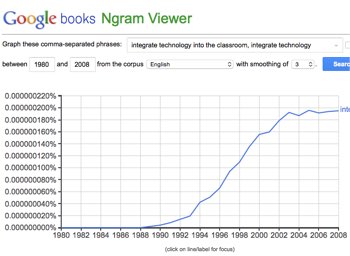One of the challenges of writing a history of educational technology is that so much of it happened before the Internet. I have been surprised and disappointed at how much of it, that I barely remember, has never been reported on the now ubiquitous World Wide Web.
As a result, I’ve had to be resourceful in my research, and one of the tools that I’ve found myself going to again and again is Google’s Ngram viewer. Here’s the situation. I’m writing about happenings just after I left the NC Department of Public Instruction and discovering that my future is going to be in training and presenting, instead of Web design and development. I believe that it was during this time when the term “Integrate technology’ was being adopted by ed tech advocates. But I’m not sure. How do I determine, on a timeline, the growing use and abuse of the term.
Enter Ngram Viewer. The default terms are Albert Einstein, Sherlock Holmes and Frankenstein. The viewer presents a line chart, illustrating the number of Google digitized books that mention the term by year, from 1500 to 2008. The default shows the gradual growth of Frankenstein from just after the publishing of Mary Shelley’s book (1818), and then a more rapid rise of Sherlock Holmes starting in the final years of the 19th century. Occurrences of Albert Einstein started in the second quarter of the 20th century and then Frankenstein, again, overtakes and surges well above, starting in the 1960s – possibly as a result of television’s re-running of Frankenstein movies released in the 1930s and ‘40s.
Entering the term, “integrate technology into the classroom,” into Ngram Viewer, I learn that, although the term started to appear in the late 1980s, its popular use started to rise in the mid-1990s, as we left the growing number of education technology conferences with our new mantra, “Integrate Technology! Integrate Technology! Integrate Technology!”
Ommmmmm!

